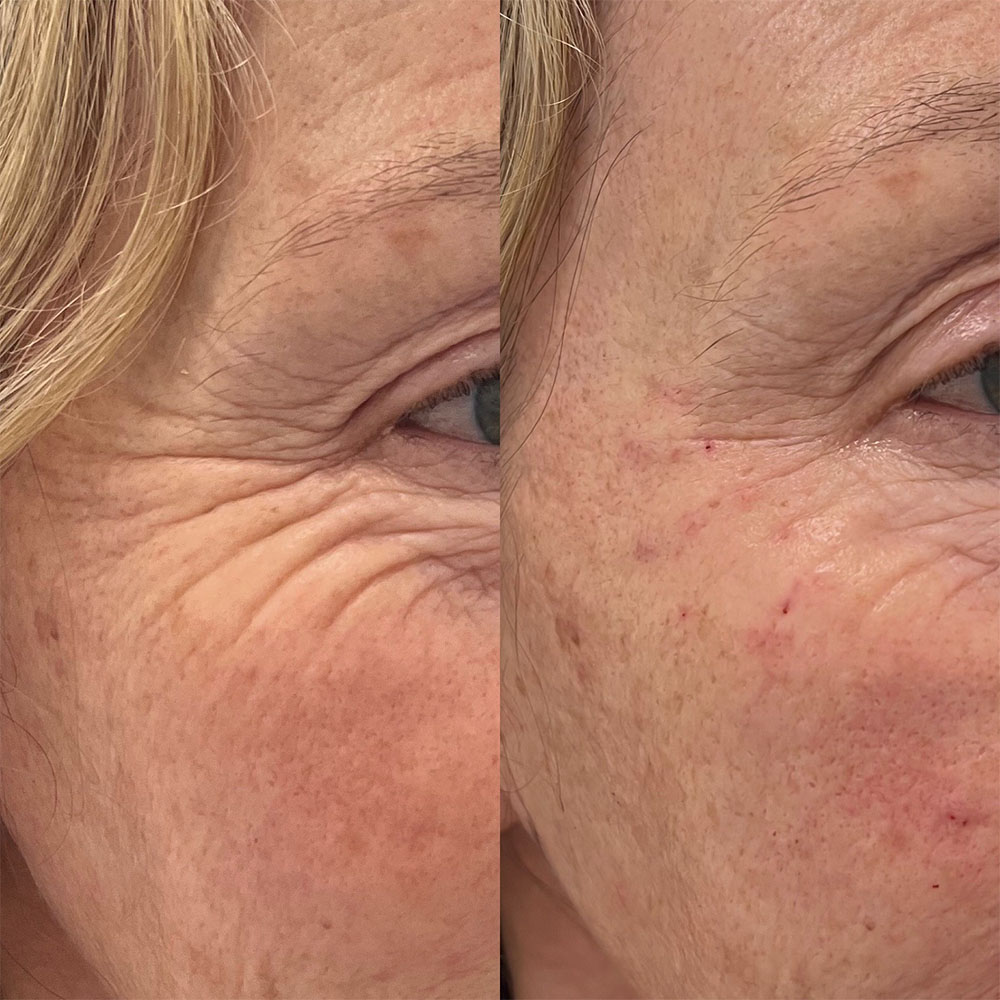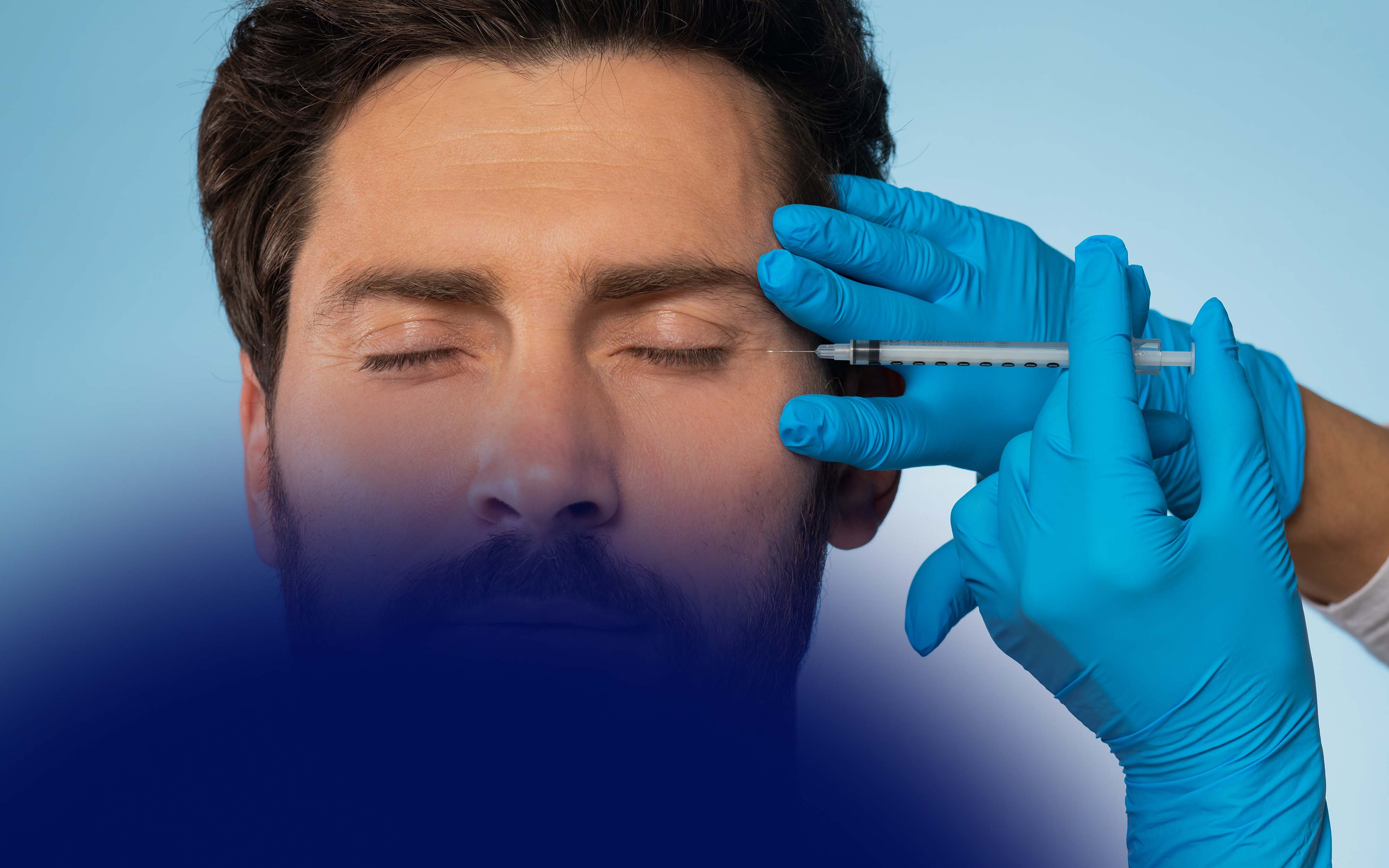
Key Takeaways
- Crow’s feet are fine lines around the eyes caused by repeated expressions, aging, and sun exposure.
- Dermal fillers can improve static wrinkles, but are not always the first treatment choice.
- Ideal candidates are patients with mild to moderate static lines who understand risks and alternatives.
- Treatment outcomes depend on the type of filler, injection technique, and the patient’s skin quality.
- Crow’s feet filler best practices include patient selection, proper technique, and setting realistic expectations.
What Causes Crow’s Feet?
Crow’s feet, also known as lateral canthal lines, appear as fine lines radiating from the outer corners of the eyes. They are often one of the earliest visible signs of aging. The main contributing factors include:
- Repeated facial expressions such as smiling, squinting, or laughing.
- Loss of collagen and elastin with age, reducing skin firmness.
- Thinning of periocular skin, which is naturally delicate and prone to wrinkling.
- Sun exposure accelerates photoaging.
- Lifestyle factors such as smoking, poor hydration, or lack of sun protection.
These wrinkles can be dynamic (visible only when moving facial muscles) or static (visible even at rest). Understanding the difference is key when deciding on treatment, since dermal fillers are better suited for static wrinkles.

Can Fillers Help Reduce Crow’s Feet?
Yes, but with limitations. While crow’s feet dermal filler can soften static wrinkles by restoring volume and supporting the skin, it is not always the first-line treatment. Botulinum toxin (Botox, Dysport, Xeomin) is generally considered the gold standard for dynamic crow’s feet because it reduces muscle activity.
That said, in patients with static wrinkles or volume loss around the lateral eye, periocular filler injection can offer improvement. Fillers may also complement botulinum toxin, providing a more complete rejuvenation.
Who Are the Ideal Candidates?
Ideal candidates for treating crow’s feet with filler typically include:
- Patients with mild to moderate static lines at rest.
- Individuals with good skin quality and elasticity.
- Those seeking improvement but with realistic expectations.
- Patients without significant skin laxity requiring surgical correction.
- People who may not be candidates for botulinum toxin but still want nonsurgical options.
A detailed consultation and facial assessment are crucial to determine whether filler is appropriate.
When Fillers Aren’t a Good Option for Crow’s Feet
Not every patient benefits from filler in this area. Contraindications or poor indications include:
- Predominantly dynamic wrinkles, better treated with botulinum toxin.
- Very thin skin where filler may cause visible irregularities.
- Severe skin laxity where surgical or energy-based treatments are more effective.
- Patients with allergies to filler components or a history of adverse reactions.
- Individuals with unrealistic expectations, expecting complete wrinkle erasure.
In these cases, alternatives such as botulinum toxin, laser resurfacing, microneedling, or radiofrequency treatments may be more appropriate.

How Long Do Fillers for Crow’s Feet Last?
The longevity of results depends on the type of filler used, the patient’s metabolism, and the treatment technique. On average:
- Hyaluronic acid fillers: 6–12 months.
- Lighter formulations (e.g., Belotero Balance) may last slightly less but integrate more smoothly into delicate skin.
Touch-ups may be necessary for optimal maintenance. Patients should be advised that results are temporary and require repeat sessions.
What Filler Is Good for Crow’s Feet?
The best dermal filler for crow’s feet is typically a soft, low-viscosity hyaluronic acid filler designed for superficial placement. Options often used include:
- Belotero Balance – known for smooth integration and reduced risk of lumps.
- Restylane Silk – a softer filler suitable for fine lines.
- Juvederm Volbella – another HA-based filler with a subtle finish.
Choosing the right product requires consideration of wrinkle depth, skin thickness, and injection technique. A conservative approach is always recommended due to the vascular sensitivity of the periocular region.
How Does the Procedure Look?
A typical periocular filler injection session involves:
- Consultation and assessment – reviewing medical history, examining wrinkle type, and setting expectations.
- Preparation – cleaning the area and possibly applying a topical anesthetic.
- Injection technique – micro-aliquots of filler are placed with a fine needle or blunt cannula to reduce the risk of bruising and vascular injury.
- Post-care – patients are advised to avoid strenuous activity, heat, and alcohol for 24 hours.
The treatment usually takes 15–30 minutes, with minimal downtime. Mild swelling or bruising may occur but often resolves within days.

Risks of Getting Filler for Crow’s Feet
Though generally safe in skilled hands, injecting filler in the periocular region carries risks, including:
- Bruising and swelling
- Asymmetry
- Visible lumps or Tyndall effect (bluish discoloration if filler is placed too superficially)
- Infection
- Rare but serious risk of vascular occlusion
Practitioners should always prioritize safety, use cannulas when possible, and be prepared with hyaluronidase to dissolve HA fillers if needed.
Potential Side Effects of Crow’s Feet Fillers
Common, temporary side effects include:
- Redness
- Swelling
- Tenderness
- Itching at the injection site
Most resolve within days, but patients should be educated about warning signs of complications, such as sudden pain, vision changes, or skin discoloration, which require urgent attention.
How to Maintain Good Results
Achieving smoother skin around the eyes with filler is only part of the journey; maintaining those results requires consistent care and healthy habits. Sun protection is one of the most important steps, since ultraviolet exposure accelerates the breakdown of collagen and makes fine lines reappear more quickly. Patients are encouraged to use sunscreen daily and to adopt protective measures such as sunglasses and hats.
Staying hydrated and following a balanced diet also helps preserve skin quality, ensuring that filler integrates well and lasts longer. Regular maintenance sessions, scheduled according to the type of filler and the patient’s individual response, are essential to prolonging the effects.
For patients with dynamic wrinkles, combining filler with botulinum toxin can provide a more complete rejuvenation, as this dual approach addresses both static lines and muscle activity. Finally, avoiding smoking and other lifestyle factors that speed up skin aging will support the longevity of the treatment and keep results looking as natural as possible.
FAQ
What’s better for crow’s feet: Botox or fillers?
Botox is generally better for dynamic lines, while fillers work for static wrinkles. Many patients benefit from a combination of both.
How to fix crow’s feet without Botox?
Options include dermal fillers, microneedling, laser resurfacing, or topical retinoids.
How to tighten up crow’s feet?
Non-surgical skin tightening with radiofrequency or ultrasound can help, as can collagen-stimulating treatments.
Will Sculptra help with crow’s feet?
Sculptra is more commonly used for volume restoration in larger facial areas. It is not typically recommended for fine periocular wrinkles.
Is Botox or Xeomin better for crow’s feet?
Both are effective botulinum toxins. Choice often depends on provider preference and patient response.
Conclusion
Using dermal filler for crow’s feet can be an effective option for the right patient, particularly those with static lines and mild volume loss around the lateral eye. The best results, however, usually come from a combination of factors, such as careful patient selection, conservative technique, and realistic expectations. While fillers on their own offer temporary improvements, they are most powerful when combined with other modalities such as botulinum toxin and good skin care.
For aesthetic professionals seeking to expand their expertise, continuing education in online aesthetic medical training for doctors and hands-on dermal filler training ensures safe and effective practice.
Sources
- Cavallini M, Papagni M, Augelli F, Muti GF, Santorelli A, Raichi M. Heterogeneous crow's feet line patterns and customized botulinum toxin rejuvenating treatment. J Cosmet Dermatol. 2022;21(10):4294-4300. doi:10.1111/jocd.15172 Available from: https://pubmed.ncbi.nlm.nih.gov/35723939/
- Kane MA. Classification of crow's feet patterns among Caucasian women: the key to individualizing treatment. Plast Reconstr Surg. 2003;112(5 Suppl):33S-39S. doi:10.1097/01.PRS.0000082192.45787.B6 Available from: https://pubmed.ncbi.nlm.nih.gov/14504483/
- de Maio M, Swift A, Signorini M, Fagien S; Aesthetic Leaders in Facial Aesthetics Consensus Committee. Facial Assessment and Injection Guide for Botulinum Toxin and Injectable Hyaluronic Acid Fillers: Focus on the Upper Face. Plast Reconstr Surg. 2017;140(2):265e-276e. doi:10.1097/PRS.0000000000003544 Available from: https://pubmed.ncbi.nlm.nih.gov/28746271/
- Varga R. Providing Optimal Rejuvenation to the Periocular Area Using Botulinum Toxin A Neuromodulators and Hyaluronic Acid Dermal Fillers. Plast Surg Nurs. 2019;39(4):119-124. doi:10.1097/PSN.0000000000000279 Available from: https://pubmed.ncbi.nlm.nih.gov/31790040/
Disclaimer:
This article is intended for licensed medical professionals. All protocols, dosages, and treatment insights referenced herein are based on published literature. The content is not intended to encourage application, diagnosis, or self-treatment of unlicensed individuals, and should not be used as a substitute for the clinical judgment of a qualified healthcare provider.

